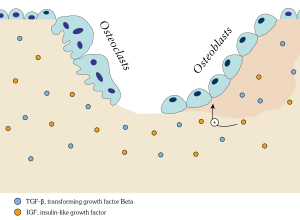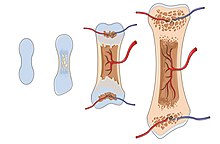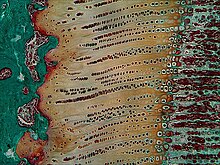

This article has multiple issues. Please help improve it or discuss these issues on the talk page. (Learn how and when to remove these template messages)
|

Ossification (also called osteogenesisorbone mineralization) in bone remodeling is the process of laying down new bone material by cells named osteoblasts. It is synonymous with bone tissue formation.[1] There are two processes resulting in the formation of normal, healthy bone tissue:[2] Intramembranous ossification is the direct laying down of bone into the primitive connective tissue (mesenchyme), while endochondral ossification involves cartilage as a precursor.
Infracture healing, endochondral osteogenesis is the most commonly occurring process, for example in fractures of long bones treated by plaster of Paris, whereas fractures treated by open reduction and internal fixation with metal plates, screws, pins, rods and nails may heal by intramembranous osteogenesis.
Heterotopic ossification is a process resulting in the formation of bone tissue that is often atypical, at an extraskeletal location. Calcification is often confused with ossification. Calcification is synonymous with the formation of calcium-based salts and crystals within cells and tissue. It is a process that occurs during ossification, but not necessarily vice versa.
The exact mechanisms by which bone development is triggered remains unclear, but growth factors and cytokines appear to play a role.
| Time period[3] | Bones affected[3] |
|---|---|
| Third month of fetal development | Ossification in long bones beginning |
| Fourth month | Most primary ossification centers have appeared in the diaphyses of bone. |
| Birth to 5 years | Secondary ossification centers appear in the epiphyses |
| 5 years to 12 years in females, 5 to 14 years in males | Ossification is spreading rapidly from the ossification centers and various bones are becoming ossified. |
| 17 to 20 years | Bone of upper limbs and scapulae becoming completely ossified |
| 18 to 23 years | Bone of the lower limbs and os coxae become completely ossified |
| 23 to 26 years | Bone of the sternum, clavicles, and vertebrae become completely ossified |
| By 25 years | Nearly all bones are completely ossified |
This section needs expansion. You can help by adding to it. (January 2021)
|
Intramembranous ossification forms the flat bones of the skull, mandible and hip bone.
Osteoblasts cluster together to create an ossification center. They then start secreting osteoid, an unmineralized collagen-proteoglycan matrix that has the ability to bind calcium. As calcium binds to the osteoid, the matrix hardens, and the osteoblasts become entrapped, transforming into osteocytes.
As osteoblasts continue to secrete osteoid, it surrounds blood vessels, leading to the formation of trabecular (cancellous or spongy) bone. These blood vessels will eventually develop into red bone marrow. Mesenchymal cells on the bone surface form a membrane known as the periosteum. Osteoblasts secrete osteoid in parallel with the existing matrix, creating layers of compact (cortical) bone.[4]

Endochondral ossification is the formation of long bones and other bones. This requires a hyaline cartilage precursor. There are two centers of ossification for endochondral ossification.
The primary center
In long bones, bone tissue first appears in the diaphysis (middle of shaft). Chondrocytes multiply and form trebeculae. Cartilage is progressively eroded and replaced by hardened bone, extending towards the epiphysis. A perichondrium layer surrounding the cartilage forms the periosteum, which generates osteogenic cells that then go on to make a collar that encircles the outside of the bone and remodels the medullary cavity on the inside.
The nutrient artery enters via the nutrient foramen from a small opening in the diaphysis. It invades the primary center of ossification, bringing osteogenic cells (osteoblasts on the outside, osteoclasts on the inside.) The canal of the nutrient foramen is directed away from more active end of bone when one end grows more than the other. When bone grows at same rate at both ends, the nutrient artery is perpendicular to the bone.
Most other bones (e.g. vertebrae) also have primary ossification centers, and bone is laid down in a similar manner.
Secondary centers
The secondary centers generally appear at the epiphysis. Secondary ossification mostly occurs after birth (except for distal femur and proximal tibia which occurs during 9th month of fetal development). The epiphyseal arteries and osteogenic cells invade the epiphysis, depositing osteoclasts and osteoblasts which erode the cartilage and build bone, respectively. This occurs at both ends of long bones but only one end of digits and ribs.


Several hypotheses have been proposed for how bone evolved as a structural element in vertebrates. One hypothesis is that bone developed from tissues that evolved to store minerals. Specifically, calcium-based minerals were stored in cartilage and bone was an exaptation development from this calcified cartilage.[5] However, other possibilities include bony tissue evolving as an osmotic barrier, or as a protective structure.
|
| |||||||||||||||
|---|---|---|---|---|---|---|---|---|---|---|---|---|---|---|---|
| Cartilage |
| ||||||||||||||
| Bone |
| ||||||||||||||
|
Development of bone
| |
|---|---|
| Ossification |
|